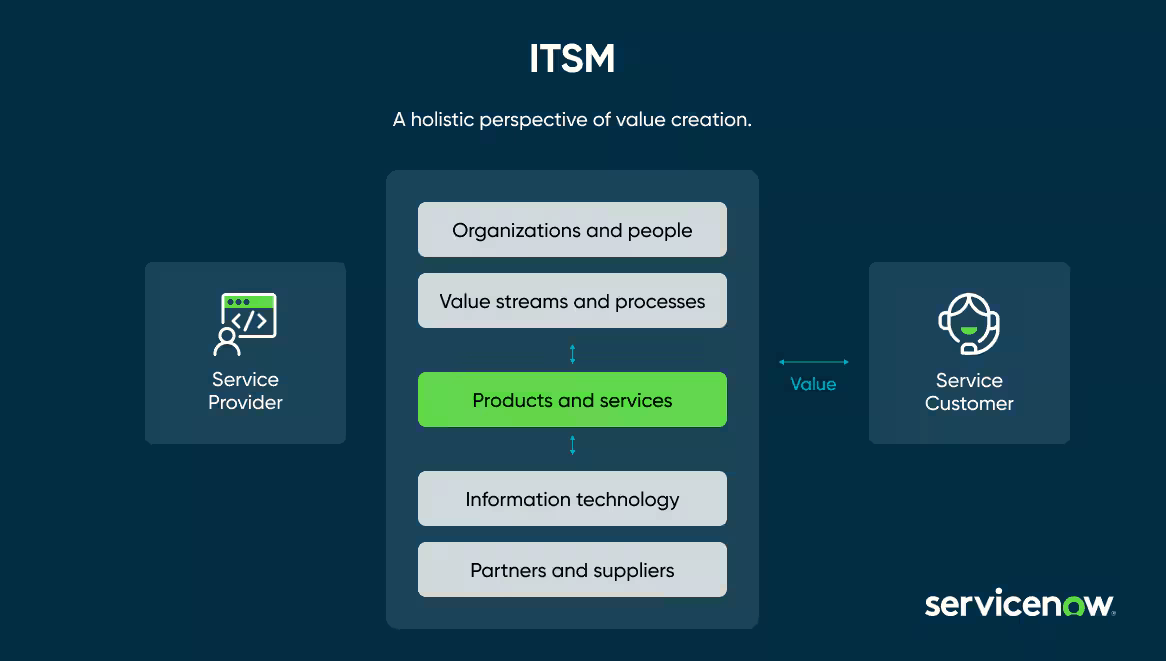When you hear “ServiceNow,” the first thing that often comes to mind is IT Service Management (ITSM). And for good reason – ServiceNow revolutionized ITSM, streamlining IT operations and enhancing employee experiences. However, to confine ServiceNow to just ITSM would be to miss the forest for the trees. The truth is, the ServiceNow platform is a robust, AI-powered digital workflow engine capable of transforming nearly every facet of an enterprise.
At its core, ServiceNow is about digitizing and automating workflows across an organization. It’s built on a single, cloud-native platform that enables seamless integration, provides real-time visibility, and empowers users with intuitive self-service capabilities. Let’s delve into how ServiceNow extends far beyond IT, unlocking efficiency and innovation across the entire business.
From IT to Enterprise-Wide Transformation
ServiceNow’s true power lies in its ability to connect disparate functions and eliminate data silos, creating a unified experience for employees, customers, and partners. Here’s a glimpse into the diverse capabilities of the Now Platform:
1. IT Operations Management (ITOM): Proactive IT with AIOps
Beyond simply managing IT services, ITOM focuses on the operational health of your IT infrastructure. ServiceNow ITOM provides:
- Discovery and Service Mapping: Gaining a comprehensive, real-time view of your entire IT infrastructure, including physical and virtual servers, networks, cloud resources, and their relationships to business services.
- Event Management: Consolidating and correlating events from various IT sources to identify and prioritize critical issues, preventing outages.
- Operational Intelligence: Leveraging AI and machine learning to analyze IT operational data, predict potential problems, and recommend proactive solutions.
- Cloud Management: Unifying the management of public, private, and hybrid cloud environments for greater visibility and control.
2. Human Resources Service Delivery (HRSD): A Modern Employee Experience
HRSD transforms the employee experience by digitizing and automating HR processes. Imagine:
- Employee Center: A personalized, self-service portal where employees can find answers to HR questions, submit requests (like leave applications or expense reports), and track their progress.
- Onboarding & Lifecycle Events: Streamlining complex HR workflows, from new hire onboarding to promotions and offboarding, with automated tasks and notifications.
- HR Case Management: Centralizing and managing all employee HR inquiries, ensuring consistent and efficient resolution.
- Knowledge Management: Providing a comprehensive knowledge base of HR policies, procedures, and FAQs.
3. Customer Service Management (CSM): Elevating Customer Engagement
ServiceNow CSM empowers businesses to deliver exceptional customer service and build lasting relationships:
- Omni-channel Engagement: Allowing customers to interact through their preferred channels (web portal, chat, phone, email, social media) while maintaining a unified view of their journey.
- Case Management: Efficiently managing customer inquiries, issues, and requests, with intelligent routing and escalation.
- Self-Service and Virtual Agents: Empowering customers to find answers independently through knowledge bases and AI-powered chatbots, reducing call volumes.
- Field Service Management (FSM): Optimizing the scheduling, dispatching, and management of field technicians for on-site service delivery, ensuring faster resolution times and improved customer satisfaction.
4. Governance, Risk, and Compliance (GRC): Building a Resilient Enterprise
In today’s complex regulatory landscape, GRC is crucial. ServiceNow GRC helps organizations:
- Integrated Risk Management (IRM): Identifying, assessing, and mitigating risks across the enterprise with a unified view of risk posture.
- Policy and Compliance Management: Centralizing policies, tracking compliance with regulations (like GDPR, HIPAA), and automating audit processes.
- Business Continuity Management: Developing and managing plans to ensure business operations continue during and after disruptions.
- Third-Party Risk Management: Assessing and managing risks associated with vendors and external partners.
5. Strategic Portfolio Management (SPM): Aligning Strategy with Execution
Formerly known as IT Business Management (ITBM), SPM helps organizations:
- Demand Management: Capturing and prioritizing new ideas and requests, ensuring alignment with strategic objectives.
- Project and Portfolio Management: Planning, executing, and tracking projects and programs across the business, providing visibility into progress and resource allocation.
- Resource Management: Optimizing resource utilization and ensuring the right people are working on the right initiatives.
6. App Engine: Empowering Citizen Developers and Pro-Coders
The Now Platform is not just a suite of applications; it’s a powerful low-code/no-code development environment. ServiceNow App Engine allows:
- Citizen Developers: Business users with limited coding experience to build custom applications and automate workflows quickly.
- Pro-Code Developers: Experienced developers to create more complex and integrated solutions, leveraging the platform’s robust capabilities.
- Accelerated Digital Transformation: Enabling organizations to rapidly develop solutions for unique business needs and address process inefficiencies.
7. Industry Solutions: Tailored for Specific Sectors
ServiceNow also offers specialized solutions tailored to the unique needs of various industries, including:
- Healthcare and Life Sciences: Streamlining patient services, managing medical devices, and ensuring compliance.
- Financial Services: Automating banking operations, managing financial risks, and enhancing customer experiences.
- Telecommunications: Unifying network operations and delivering proactive customer care.
- Manufacturing: Driving operational efficiency, managing assets, and optimizing field service.
- Public Sector: Modernizing government services and improving citizen engagement.
The Undeniable Benefits
The power of the ServiceNow platform, extending far beyond ITSM, delivers a multitude of benefits:
- Increased Efficiency and Automation: Automating repetitive tasks and streamlining workflows across departments.
- Improved Employee and Customer Experiences: Providing intuitive self-service options and faster resolution of requests.
- Enhanced Visibility and Control: Gaining a holistic view of operations, risks, and performance.
- Faster Innovation: Empowering teams to rapidly build and deploy custom applications.
- Greater Business Agility: Adapting quickly to changing market demands and business needs.
- Reduced Costs: Optimizing resource utilization, minimizing manual efforts, and preventing outages.
In essence, ServiceNow is a platform for digital transformation, empowering organizations to connect their people, processes, and systems on a single, intelligent foundation. While its roots are firmly in ITSM, its branches now reach every corner of the modern enterprise, proving that its true power lies in its ability to drive efficiency, innovation, and exceptional experiences across the entire business.



